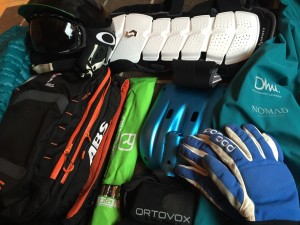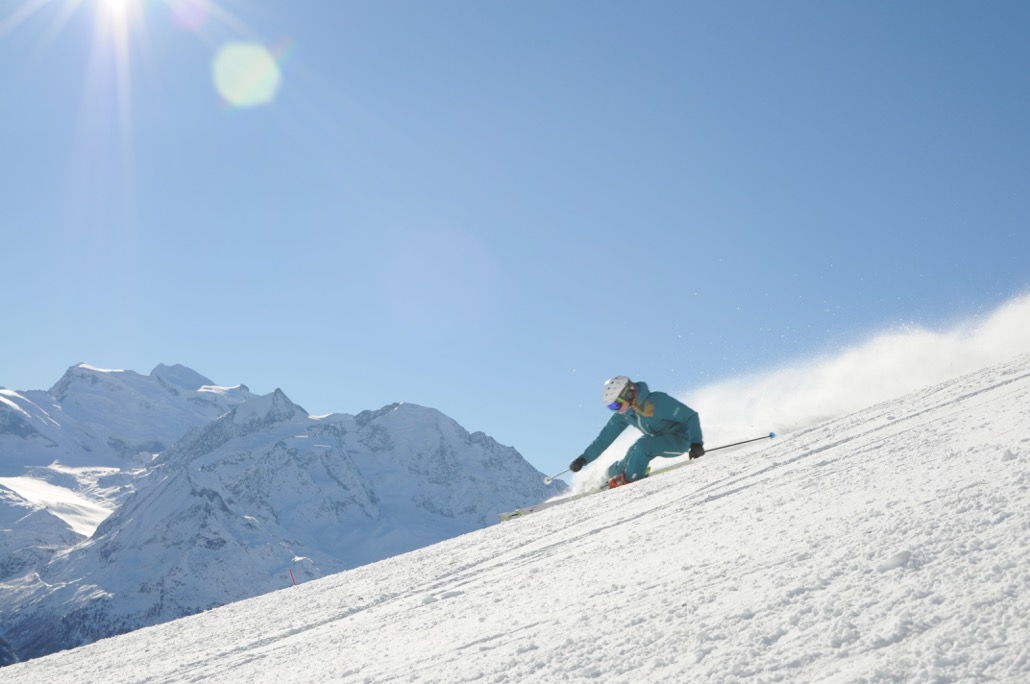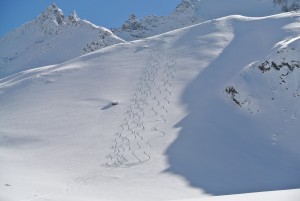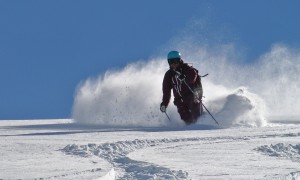Heading off-piste?
Finally! The snow is here!
After a long a patient wait we are finally getting our fair share of snow. Televerbier have done a fantastic job maintaining the pistes so far this season but with all this new snow some of you may plan to venture into the natural and un-controlled terrain.
Skiing in the off-piste is a lot of fun and Verbier boasts some of the best freeride terrain in the Alps however, it can also be very dangerous. So before we go hooning off into the wilderness of powdery goodness here are a few things to consider.
Avalanche safety equipment
If you are skiing off-piste you MUST have the following and this applies to all of the people you are with:
- Avalanche transceiver (with a battery that isn’t about to run out)
- Snow shovel
- Avalanche probe
(And a back pack to carry it all in)
These are the basic things you need to have with you. Treat them all as one and not three individual things – They all compliment each other and are all useless if you were missing one. Also, just because you own (or have rented) these three pieces of equipment I recommend you have some sort of training so you know how to use them all properly in an emergency situation – the correct and efficient use of this equipment could just save someone’s life!
With that said, would you really want to ski off-piste with people who had but didn’t know how to use this equipment? Your life is effectively in their hands.
I also recommend:
– A helmet
– Adequate clothing
– First Aid Kit
– Mobile phone (but do not carry it next to your transceiver as it can interfere with the signal your transceiver emits)
– Spare layer or fleece
– Some water or something to drink (not beers – that’s later in the Après ski)
– Having helicopter insurance
Optional safety equipment:
– Back protector
– Avalanche Airbag (e.g. ABS, Snowpulse etc)
– Avi-lung
The avalanche risk rating
This is the professionally decided rating on the average likelihood of triggering an avalanche. It takes into account the current amount, quality and bonding of the layers in the snowpack.
It can be found at any of the main lift stations on an information board (usually with a flashing light next to the corresponding number) Some of these locations are; one at the top of the steps as you walk up to get into the gondola at Medran and one in between the escalators and the walk to the turnstiles for the Funispace at Ruinettes.
The ratings are as follows:
1 – low risk
2 – moderate risk
3 – considerable risk
4 – high risk
5 – very high risk
I would recommend never skiing off-piste when the rating is a 4 or 5 and only if it is 1, 2 or 3. Having said that, most cases of people being involved in some sort of avalanche situation occur when the rating is a 3 – people think they will be safe as it is the ‘middle ground’ between 1 and 5. WRONG! Pay attention to what the number actually means and a 3 actually says considerable risk. You must take this into account. Avalanches also occur when the rating is a 1 too.
Taking part in a mountain safety course
This is optional but highly recommended extra training on top of your Transceiver, Shovel and Probe training.
There are many courses you can take part in – some are a few days and some are just a 3 hour morning session.
It can help you understand the off-piste in a lot more detail thus can help you minimise the chance of triggering an avalanche. As the saying goes, prevention is better than cure.
Things your course may include are:
- Use of safety equipment
- Understanding the snow pack
- Causes of avalanches
- Effects of weather
- How to assess the risk
- How to avoid avalanches
- Reading the terrain
Hire a guide
Hiring a mountain guide for the day really can be worth it. They know loads about the area and can show you some of the best off-piste skiing Verbier has to offer.
They can also help you find some of the best snow around that you may have otherwise missed if you headed off-piste with just you and your friends.
Most importantly, they can help keep you safe by using their invaluable mountain knowledge, experience in reading the terrain and understanding the snow pack.
Some final points
Here are a few final points to take away with you.
Never ski off-piste alone – This is a no brainer right? I mean, if something happened and no one is there to help you this would be a pretty bad situation.
All the gear and no idea… – Have appropriate training with your Transceiver, Shovel and Probe and know what to do in an emergency. I cannot stress how important this is. I don’t mean to go away on a 3 week training expedition but some sort of course, training or practice with your equipment would be a good idea.
And also,
If in doubt, don’t – Not sure that face or couloir you have been eyeing up for a while is safe at the moment? Then don’t do it. Ski somewhere else. There will always be another day.
Stay safe, enjoy.
Lawrie

We all knew it was going to come. We just didn’t know when. Well we had a good 50cm up the hill over the past couple of days and there is more to come. Caroline (wife not instructor) and I went out for a quick belt around whilst little Caspar was in child care (he will never know). It was amazing:
So all this chat of El Nino we all expected to have the most amazing season of snow. Well it certainly didn’t start that way. The only snow that has fallen this season was in late November. Albeit a good snowfall it certainly wasn’t enough to kickstart the season.
Hats off to TeleVerbier who managed to keep the link to the 4 vallee’s open until yesterday and at least 2 or 3 runs on Savoleyres have been skiable and very quite. Now it’s NY week it’s certainly busier but up high the snow conditions are great.
The great news is that a storm from the atlantic is gaining some momentum and heading our way. It looks like we’re going to get a reasonable snow fall over a 7-10 day period. Cutting it a bit fine…!
A quick guide to choosing the right skis this winter – We’re here to help!
Do you find it difficult to know which skis to choose? Don’t worry, you’re not alone, with a never-ending choice of skis to pick from, we’ve created this quick guide to help point you in the right direction!
So, which type of skis should you go for?
First of all, you should think about where on the mountain and when you will be using your skis.
If you know that you will only be enjoying groomed slopes this winter, then a piste ski is what you’re looking for. In an ideal world, the best solution would be to have several pairs of skis if you were riding all over the mountain. However, for most us, our wallet doesn’t stretch that far nor is it the most practical! Yet due to the dramatic advancement in ski technology, manufacturers have brought out skis that work on all types of terrain from on piste to off piste. It does have to be said that those looking to enjoy steep and deep powder, your life would be made a whole lot easier if you choose a wider option as it will aid you both in floatation and movement in deep powder snow. So have a think about where you will be riding on the mountain…
PISTE SKIS
A piste ski is designed and manufactured to perform well on groomed slopes. They are built to handle harder surfaces and icier conditions. Here you have two options; a ski solely designed for slalom that will be a little shorter in length but works well for fast and quick carved turns or a giant slalom ski that is suited toward high speeds and longer turns and requires a sturdier construction to handle those high speeds and keep an edge.
FREERIDE SKIS
A freeride ski is designed to be used in all conditions, both on the piste but also outside the groomed slopes, off piste. The waist on these skis is a little wider than the pure-piste skis, making the ski easier to use in variable snow conditions. A great choice for those looking to go all over the mountain.
POWDER SKIS
The widest skis on the market; these are usually 100mm or wider on the waist to help both float and ease of use in powder. These skis will be a bit more difficult and slower in groomed conditions, but if you are seeking out steep and deep powder then these are the obvious choice!
TWIN TIP SKIS
Are you looking to venture into the snowpark? Some of these skis are perfectly symmetrical and come with mid-mounted bindings which means they should work just as well going backwards as forwards. Therefore, these models are raised both at the front and rear of the ski. Some twin tip skis can be good all mountain options and can also be used off piste thanks to them being made slightly wider.
WOMENS SKIS
All manufacturers today make women’s models, this is because women generally weigh less and will not put the same pressure on the skis as men. A women’s ski is a little lighter than the corresponding men’s ski and the binding may also differ to improve and facilitate the way the ski handles.
There is absolutely no need to use a women’s model if you are a good and strong skier but if you are a beginner/intermediate, we would recommend it because it will make your skiing easier.
WHAT IS ROCKER?
A ski equipped with rocker primarily means that the ski’s nose begins earlier on the ski. This has been developed to improve ride quality and fluidity in looser snow conditions. The result is that the ski runs smoothly over bumps and the edges dont get caught on small ridges on the slopes.
WHAT IS TURNING RADIUS?
Turning radius is determined by the arch of the ski, which is a measure of the relationship between different parts of the ski; tip, waist and back end. The arch together with the length of the ski determines how sharp the ski turns when you put it on edge.
Slalom skis are very short and snappy in the turns and always have a short turning radius while giant slalom skis that will be skied in longer faster turns have a greater turning radius.
RENTING OR BUYING
That’s a tricky question and there are pros and cons to both.
If you rent your skis you will always be able to get the latest models and technology and you don’t have to carry your skis with you when you travel.
If you buy your skis you will always know what you get (and hopefully like) and how your skis are going to perform in different conditions because you have skied on them for a while.
From a financial point of view there is a good rule of thumb – if you ski less than 3 weeks a year rent your skis and if you ski for more than 3 weeks buy them. That is the breakeven point if you compare renting vs. buying, servicing and transporting your own skis.
And remember, you can always ask your instructor for help with buying skis, they are probably the people who know the most about your skiing and what type of skis you need.
See you on the slopes!
Kenta

FIND THE RIGHT SKI BOOTS
Ski boots are probably the most important component of your equipment; there is nothing that can ruin a day’s skiing in the same way as achy feet from a pair of boots that don’t fit correctly. Believe it or not, a common problem for those who get pain in their feet is that their boots are too big. If your ski boots are too big you will have to tighten the buckles on the boot very hard to get the foot to stay in place. By doing this you push down the arch of the foot and that cuts off the blood supply. This is what gives you the cramping sensations and cold toes for most of the day on the ski slopes!
A lot has happened in the development of ski boots in recent years, previously you had to choose between functionality and comfort. Today you can combine the two and find a boot that has a snug fit whilst still being able to go an entire day without even thinking about undoing the buckles.
- CHOOSE THE RIGHT BOOT
The first thing you should consider is your ability and be honest with yourself! Are you a beginner? Have you skied since you were a child? This is so that the boot can cope with the power transfer to the ski when you put pressure on it to get the ski through the turn. This will differ very much with what kind of skier you are. If you are going to hang around in the park and do more playful skiing, you will want a slightly softer boot. For hard charging piste skiing you will require a stable and rigid boot and for freeriding you are looking for something in between. Your sports shop should be able to tell you the flex of all their ski boots, if they cant you should probably go somewhere else because that means they don’t know what they are doing! The flex for women’s boots varies between 60-110cm and for men between 70-140cm normally.
- MEASURE LENGTH
The second thing you should do is measure your foot to find the right size; this is most easily done with a pen and paper. Stand up with you heel against a wall and on paper, mark with a pencil on the edge of your big toe and then measure the distance on the paper.
- MEASURE WIDTH
The third is to classify your foot width; do you have narrow, medium or wide feet? You will usually have a pretty good idea of what type of foot you have, given all the shoes you have used throughout your life.
- SKI BOOT SIZING
Ski boot sizes are indicated in Mondo size, which means centimeter measurements internally. So if your foot measures 27.2cm choose size 27.5.
When you put your foot down in the boot the toes should hit the front edge of the boot. When you then tighten the buckles your foot will slip back into the heel grip of the boot and when you flex the knee forward the toes should not touch the front any more. The inside of your boot will widen 3-4mm after a couple of hours of skiing.
WHAT ARE THE LATEST TECHNOLOGIES TODAY?
MOLDABLE LINERS – everything from foam injected to heat molded, its your wallet that has to make the decision! Remember that you can probably have your ski boots for much longer than your skis if you get it right.
INSOLES – this is an easy and cheap way to improve your new or old ski boots. If you look at the original insole in your liners it will remind you of a rag that you use in the kitchen. Then you look at your running shoes and there you will find arch support and a really good fit for the whole foot. We want the same in our ski boots. You can get them custom molded or there is a few brands that makes a well built universal insole, again it’s a question of money.
WALKMODE – is a feature that allows the ski boot to flex a lot more and feel softer.
It’s a great feature for free ride skiing when you might be hiking places, other obvious advantages is lunch and when you hit the dance floor at après ski.
BOOSTER STRAP – the strap that sits at the top of the boot enables you to have closer contact with the tongue and improves the fit of the entire boot. It also gives you good support when you ski and may be adjusted depending on how aggressive you are planning on going.
RENTING OR BUYING
I would always recommend buying your own ski boots unless you are a child and still growing. If you are a normal skier with 2-3 weeks of skiing every year your boots will last you 5-7 years and that will be money well spent.
Your feet are so personal and as we stated at the start, is it worth ruining your holiday with achy feet?
See you on the slopes!
Kenta
Below is a press release from TeleVerbier…..
You can ski in Verbier from Friday, November 27th!
More than 70 cm of fresh snow fell in Attelas 40cm to Ruinettes, and 30cm in the resort allowing Téléverbier to open its slopes every day this Friday. This week we could enjoy freezing temperatures in order to work optimally with our mechanical snowmaking system between Attelas and Ruinettes and the Chaux. We are already able to open much our area: Lac des Vaux, the Attelas-Ruinettes and the red track of Chaux.
Other runs from the ski area will be operational depending on snow conditions. Here are the runs and facilities that will be open daily from Friday,
The cable car Châble – Verbier 8:40 a.m. to 7:30 p.m. (domain access)
- Cable car Verbier – Les Ruinettes from 8:45 a.m. to 4:15 p.m. (access to area trails closed)
- Funispace from 8:55 a.m. to 4:15 p.m. and run Attelas
- Chairlift Lac des Vaux and one blue ski slope Lac des Vaux 9:05 a.m. to 4:15 p.m.
- Chairlift Lac des Vaux and two red trail from the Lac 9:15 a.m. to 4:00 p.m.
- Cable car of the express train Chaux from 9:00am to 16:15pm and red run
- Gondolas Tzoumaz-Verbier-Savoleyres 8:45 a.m. to 4:15 p.m. for connection (weekends only)
- Chairlift and gondola Siviez-Tortin-Chassoure from 9:00 a.m. to 4:15 p.m. (connection only and weekends only)
The restaurants “the Chalet Carlsberg”, where Italy is invited, and “Olympic” will welcome this Friday and self-service “Black Sheep” Saturday.
Crates Médran (Verbier) and Châble this Friday will be open daily from 8:30 to 16:30 and those of La Tzoumaz pending the opening of Savoleyres sector, Saturdays and Sundays from 08:30 to 16 h15.
More than 70 cm of fresh snow fell in Attelas 40cm to Ruinettes, and 30cm in the resort allowing Téléverbier to open its slopes every day this Friday. This week we could enjoy freezing temperatures in order to work optimally with our mechanical snowmaking system between Attelas and Ruinettes and the Chaux. Grace the tremendous work of our teams, we are already able to open much our area: Lac des Vaux, the Attelas-Ruinettes and the red track of Chaux
We’ll keep you updated when more info comes in…! Happy skiing



